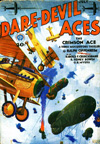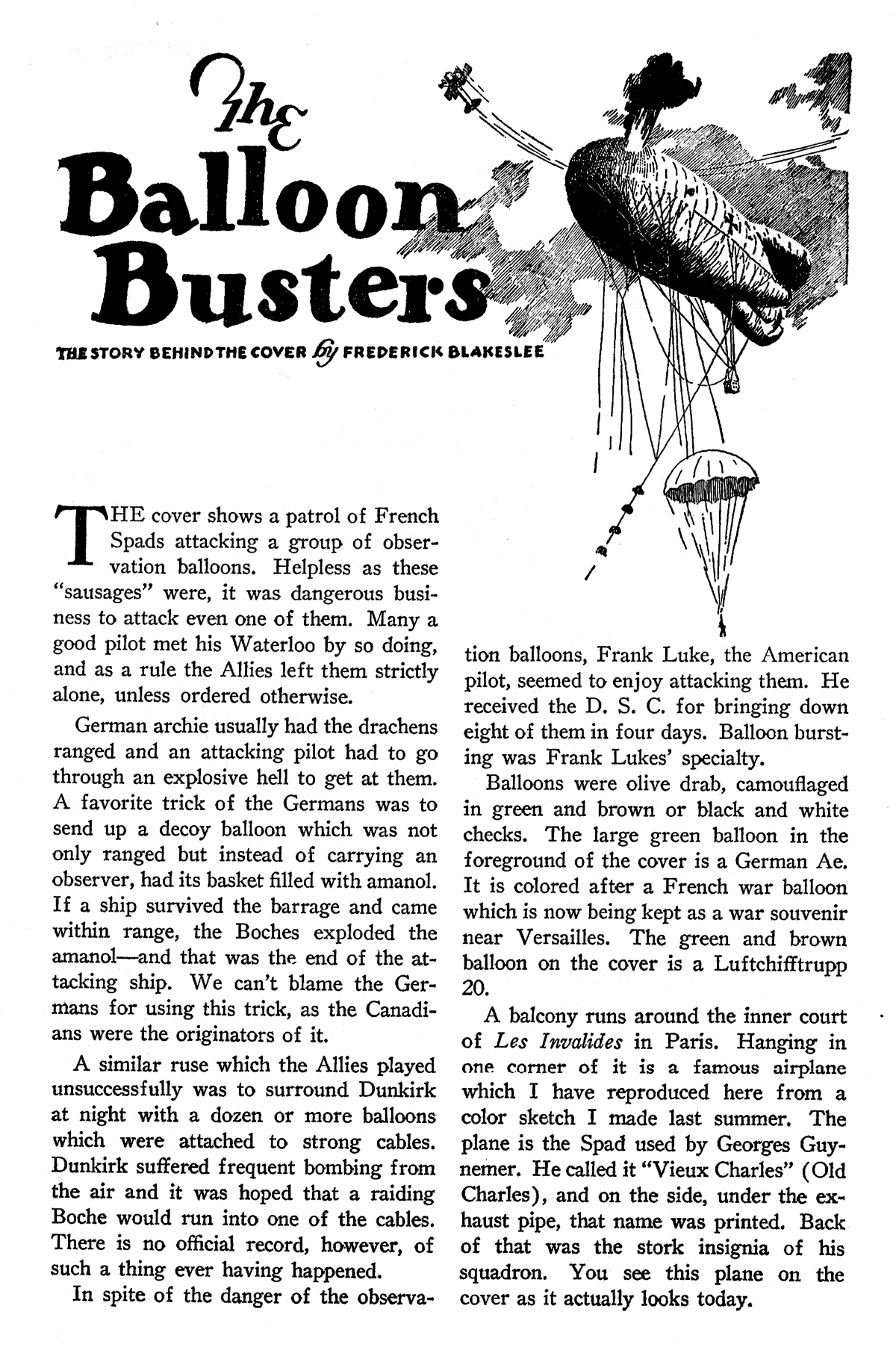LESTER DENT is best 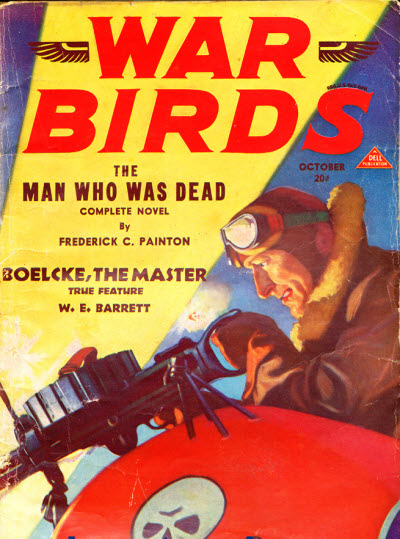 remembered as the man behind Doc Savage. But he wrote all number of other stories before he started chronicling the adventures of everyone’s favorite bronze giant. Here we have an action-packed tale of the air—The Boche have developed an even faster and better plane and Major Sam Flack has been called in to double bluff a captured Boche agent into taking him behind enemy lines to the prototype!
remembered as the man behind Doc Savage. But he wrote all number of other stories before he started chronicling the adventures of everyone’s favorite bronze giant. Here we have an action-packed tale of the air—The Boche have developed an even faster and better plane and Major Sam Flack has been called in to double bluff a captured Boche agent into taking him behind enemy lines to the prototype!
They played the double-cross both ways from the middle—when it boomeranged on the major none knew which way the fire would fall.
If you enjoyed this story, Black Dog Books has put out an excellent volume collecting 11 of Lester Dent’s early air stories set against the backdrop of World War !. The book includes this story as well as others from the pages of War Birds, War Aces, Flying Aces, Sky Birds and The Lone Eagle. It’s The Skull Squadron! Check it out!
And as a bonus, here’s another article from Lester’s home town paper, The LaPlata Home Press, this time reprinting a feature on Dent originally published in The Daily Oklahoman!
Oklahoma Biographs Lester Dent,
The Wizard Of The Pulps
The LaPlata Home Press, LaPlata, MO • 29 June 1939

Lester Dent is one of the most valid of cosmopolitans. He was born in Missouri. Was taken to and lived on a series of farms near Broken Arrow (Oklahoma). Just in time to avoid having oil struck on his place. Dent’s father sold out and the family moved to a godforsaken cow ranch in the Wyoming sagebrush.
Then back to Missouri, in 1918, when Dent was 12 years old. Only 33 years old now, he has lived almost everywhere. Recently he returned from a treasurer hunt in the Caribbean on his schooner, “The Albatross”. His home, he says, is wherever he happens to be sitting at his typewriter at the moment. Just at present, that is New York. However: “I guess I’m more Oklahoman than anything else, having lived there longer than anywhere else by about five years.”
Dent got to the fifth grade, moved to another place, and entered high school. There he flunked English for four consecutive years, after which a disgusted teacher asserted that he was hopeless along that line. Graduated from high school in 1923, and took a course in telegraphy. Got a job at $45 a month, later worked nights for the Associated Press in Tulsa.
While on that job, Dent started writing adventure stories. Sent one of them to George Delacorte of the Dell Publishing Company. Delacorte wired him to come to New York if he was making less than $100 a week. “But,” says Dent, “I thought he was nuts. I’m still not sure—” Anyway, after telegraphing friends in New York to inquire about the publisher’s sanity, he went to New York. He was given two magazines (”Scotland Yard” and “Sky Riders”) to fill. Dent cleaned up 4,000 bucks the first month, and as much monthly for three more magazines. Then both magazines went broke. That was in 1931—the depression had arrived. For the next six months he would sell a story to a magazine and before he could sell it another one, that magazine would fold up. Finally he found some that were on an even keel.
Dent’s work has been for the pulp magazines. He has sold to over 30 publications, of the cowboy, detective, adventure, air, and mystery types. Also to writers’ magazines. He uses a dozen pen names, including Kenneth Robeson, Maxwell Grant, H.O. Cash, Tim Ryan, and various others. Has long ago lost track of just how many years he has sold, although he knows the total is more than 1,000. For the last three years he has received not one rejection slip; in fact, the stories were contracted for in advance.
Dent is the second most prolific author in the world. For a year his output was an average of 200,000 words a month, all of which he sold. That, he says, is not his limit. Here’s how he works: Out of bed at 11 a.m., works until about 4 p.m.; reads the papers, takes a walk, naps for an hour; then works until 3 or 4 a.m. Does this five days a week. Biggest production for a day: On dictaphone, 32,000 words; on typewriter, 24,000 words. Most words turned out in a continuous session: 45,000 words (a book). This required a night, day, and part of night. He never revises. His copy comes out of machine and goes in “as is”.
Under the nom de plume of Kenneth Robeson, Dent writes monthly a 60,000-word (book-length) “Doc Savage” story. The “Doc Savage Magazine” was the most successful pulp magazine in the world the sec-year of its existence. Dent claims his character, Doc Savage, is an unconscious composite of the physical qualities of Tarzan of the Apes, the detective ability of Sherlock Holmes, the scientific sleuthing mastery of Craig Kennedy, and the morals of Jesus Christ. He has written perhaps 50 novels about his creation, at present being over a year ahead of the magazine which prints them.
The following should encourage embryo writers. Dent swears it’s true: “Pulp magazines are more widely open than ever for new writers. Just send them a half-way printable story and they’ll buy it. . . The pulps are an excellent training field. When I started writing for them, less than eight years ago, T.S. Stribling and MacKinley Kantor were only pulp hacks.”
Dent regrets that be has written under so many pseudonyms, instead of building up one name—his own—in the pulps. The mistake was made partly because of the fact that editors don’t like to carry more than one story under the same name in a single issue of a magazine. So Dent would sign one with his real name, and others with noms de plume. Occasionally, he has written entire issues of magazines in this manner. Consequently, although his output ranks among the greatest, his name is not especially well known.
Asked if he entertained any unrealized literary ambitions. Dent replied. “One million of them, all made of silver called dollars, and in banks, preferably several banks.” Everything considered, this is not a vain desire at all—for Mr. Dent.
(Copied from The Daily Oklahoman. Sunday, July 19, 1936.)
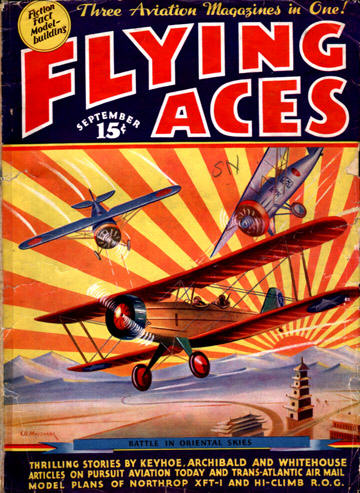 That sound can only mean one thing—that Bachelor of Artifice, Knight of Calamity and an alumnus of Doctor Merlin’s Camelot College for Conjurors is back—Yes it’s the marvel from Boonetown, Iowa himself—Lieutenant Phineas Pinkham! Red Riding Hun has been terrorizing the trenches and the Boonetown marvel concocts an ingenious plan to bring an end to their reign of terror!
That sound can only mean one thing—that Bachelor of Artifice, Knight of Calamity and an alumnus of Doctor Merlin’s Camelot College for Conjurors is back—Yes it’s the marvel from Boonetown, Iowa himself—Lieutenant Phineas Pinkham! Red Riding Hun has been terrorizing the trenches and the Boonetown marvel concocts an ingenious plan to bring an end to their reign of terror!




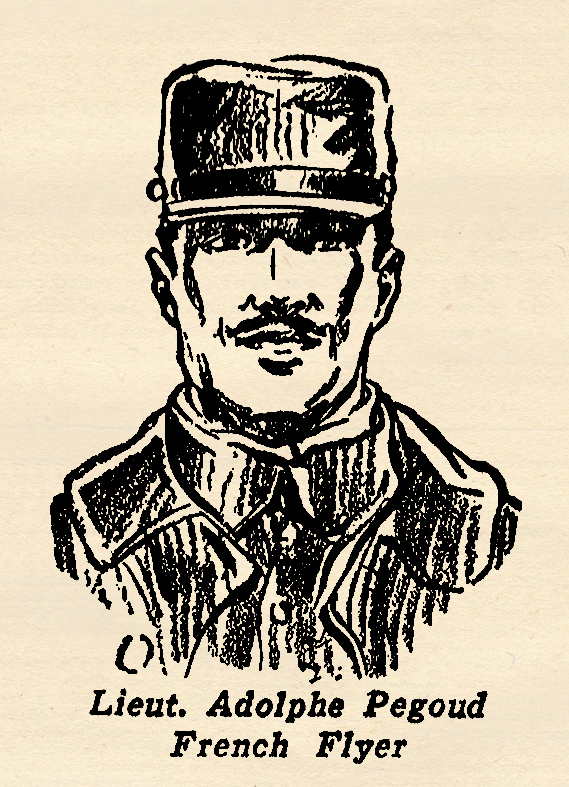 famous flyer before the war began. In 1913, flying a tiny Bleriot monoplane, he astonished the world by doing a series of intricate air maneuvers. Later, he made an upside down landing, the first and to this day the only aviator deliberately to perform such a stunt.
famous flyer before the war began. In 1913, flying a tiny Bleriot monoplane, he astonished the world by doing a series of intricate air maneuvers. Later, he made an upside down landing, the first and to this day the only aviator deliberately to perform such a stunt.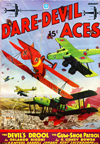
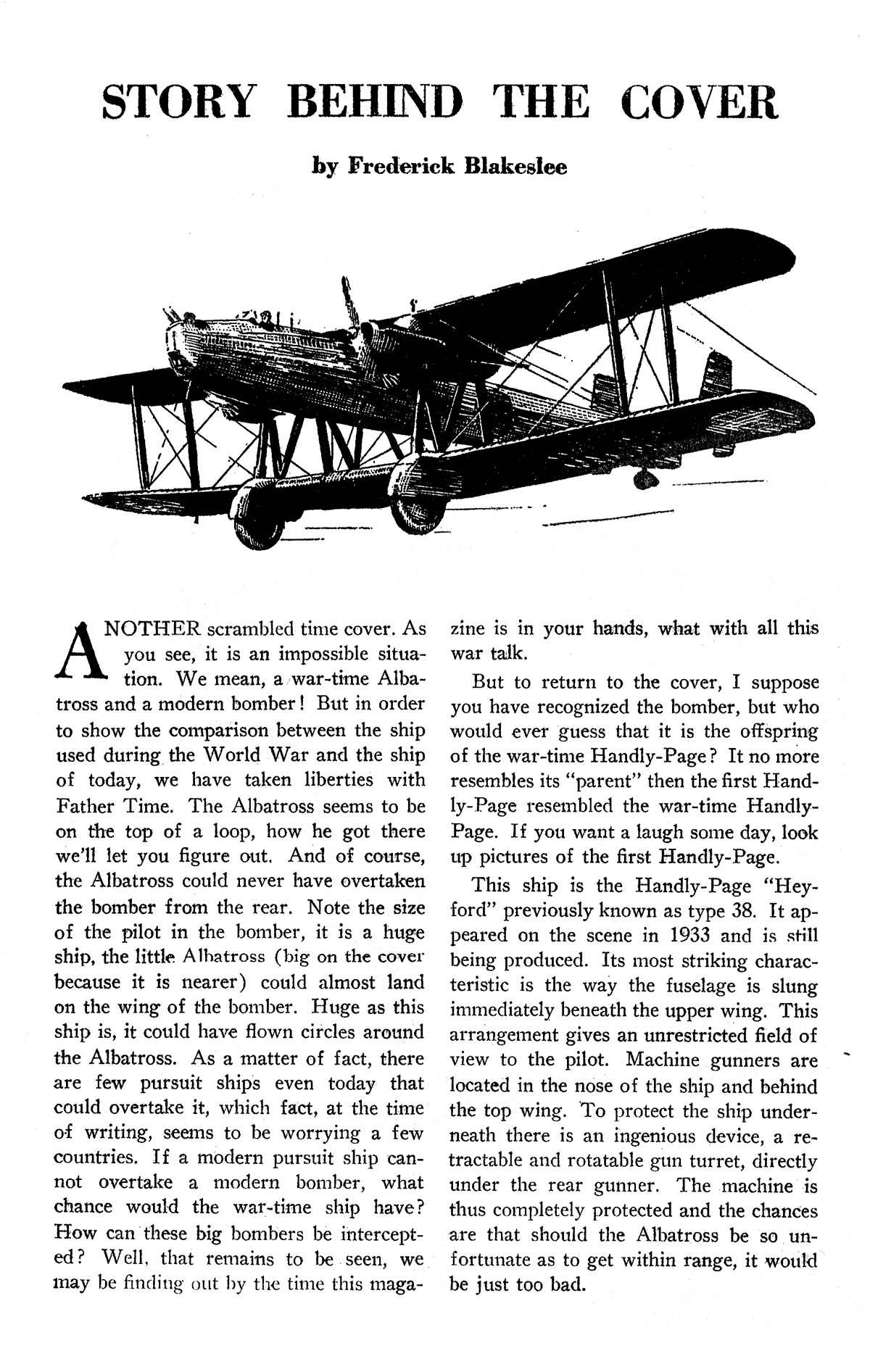
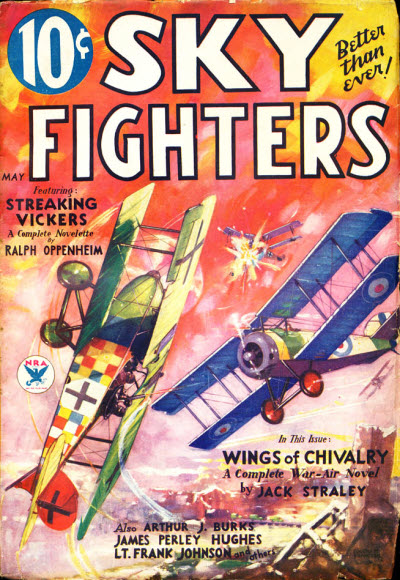 ironically named for his penchant to boast, but blessed with the skills to carry out his promises—comes up against a trio of skilled acrobatic flyers that manage to elude the most skilled flyers while downing three enemy planes in every encounter, but Orth asks for one day to do the impossible and take down the trio! From the May 1934 issue of Sky Fighters it’s Silent Orth in “Sunset Song!”
ironically named for his penchant to boast, but blessed with the skills to carry out his promises—comes up against a trio of skilled acrobatic flyers that manage to elude the most skilled flyers while downing three enemy planes in every encounter, but Orth asks for one day to do the impossible and take down the trio! From the May 1934 issue of Sky Fighters it’s Silent Orth in “Sunset Song!” remembered as the man behind
remembered as the man behind 
 France when the World War began. Being immensely wealthy in his own right, he offered to furnish and equip an entire squadron of planes and pilots. The French Army would not accept this generous offer, but Prince, acting in co-operation with William Thaw of Pittsburgh, convinced the officials that they could muster enough Americans to man an entire squadron. Their offer was accepted, and the LaFayette Escadrille was born. A French officer was put in command. All the rest of the pilots were American. Prince’s death was tragic. Though wounded in an air battle, he managed to fly his crippled plane homeward, and was about to land on his own airdrome in the gathering darkness when his plane ran into a telephone pole and crashed. In his weakened condition he did not have strength enough to guide his plane over or around the obstacle. So perished one of the bravest and most courageous of the early American pilots who gave their lives for France. The story below was told to a French reporter.
France when the World War began. Being immensely wealthy in his own right, he offered to furnish and equip an entire squadron of planes and pilots. The French Army would not accept this generous offer, but Prince, acting in co-operation with William Thaw of Pittsburgh, convinced the officials that they could muster enough Americans to man an entire squadron. Their offer was accepted, and the LaFayette Escadrille was born. A French officer was put in command. All the rest of the pilots were American. Prince’s death was tragic. Though wounded in an air battle, he managed to fly his crippled plane homeward, and was about to land on his own airdrome in the gathering darkness when his plane ran into a telephone pole and crashed. In his weakened condition he did not have strength enough to guide his plane over or around the obstacle. So perished one of the bravest and most courageous of the early American pilots who gave their lives for France. The story below was told to a French reporter.